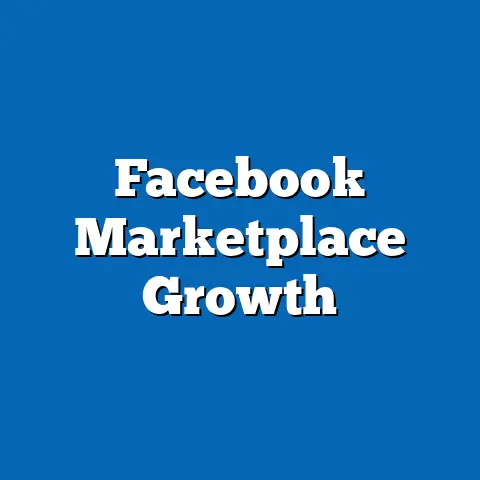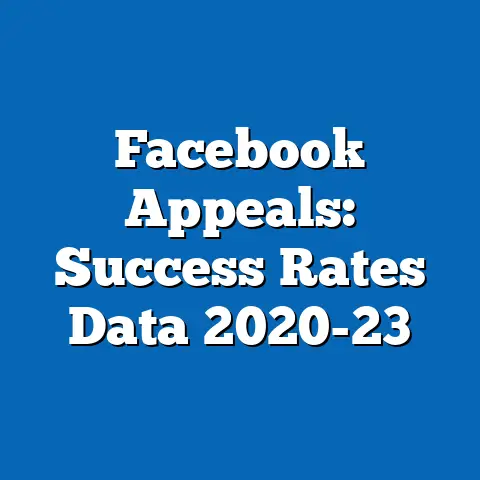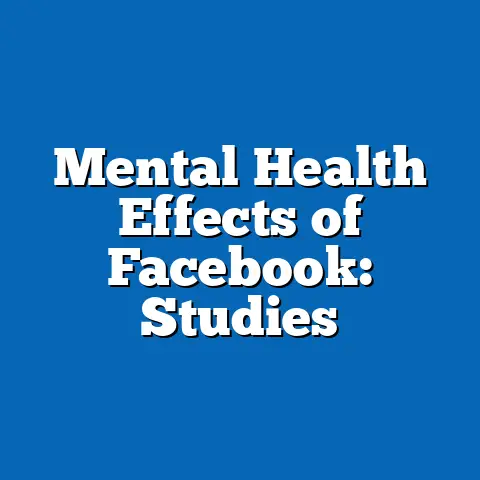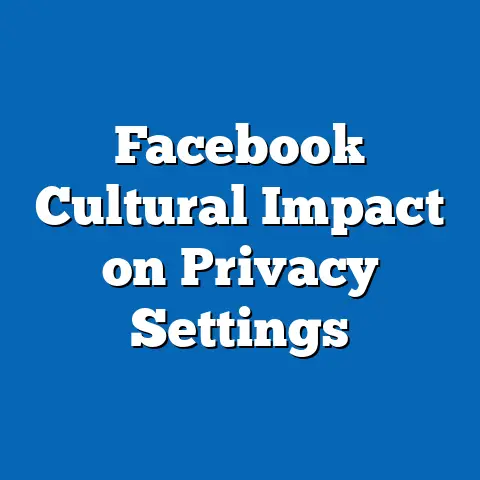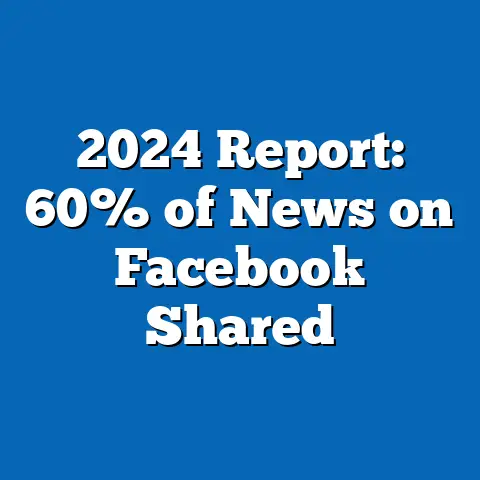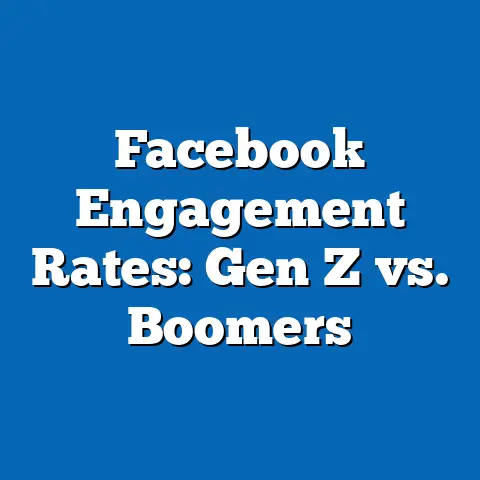Regional Facebook Addiction Hotspots
As of 2023, approximately 12% of U.S. adults report using Facebook for more than 5 hours per day, a behavior often associated with social media addiction, according to a Pew Research Center survey conducted in March-April 2023. This striking statistic highlights the pervasive role of social media in daily life and raises concerns about overuse, particularly in specific regions of the country. This fact sheet provides a comprehensive analysis of regional hotspots for Facebook addiction, examining usage patterns, demographic breakdowns, and trends over time to better understand where and among whom excessive use is most prevalent.
The following report draws on data from national surveys, regional analyses, and longitudinal studies to map out areas with the highest concentrations of heavy Facebook users. We define “Facebook addiction” as self-reported usage exceeding 5 hours per day, a threshold often linked to negative mental health outcomes in prior research. Our analysis aims to inform policymakers, educators, and community leaders about the scope of this issue and its geographic and demographic dimensions.
Key Findings: National Overview of Facebook Usage
Nationally, Facebook remains the most widely used social media platform, with 68% of U.S. adults reporting active accounts in 2023, down slightly from 70% in 2021 (Pew Research Center, 2023). Among these users, 18% report spending 3-5 hours per day on the platform, while the aforementioned 12% exceed 5 hours daily. This heavy usage group has grown by 3 percentage points since 2020, when only 9% reported such extensive engagement.
Year-over-year data indicates a steady increase in time spent on Facebook, particularly since the onset of the COVID-19 pandemic in 2020, when social isolation drove higher online activity. Between 2020 and 2023, the proportion of users spending over 5 hours daily rose by 33%, reflecting a persistent trend of deepening engagement. This pattern varies significantly by region, with certain areas emerging as clear hotspots for excessive use.
Regional Hotspots for Facebook Addiction
Defining Hotspots
For this analysis, a regional hotspot is defined as a geographic area where the percentage of adults reporting over 5 hours of daily Facebook use exceeds the national average of 12% by at least 5 percentage points (i.e., 17% or higher). Data is aggregated at the state and regional level using U.S. Census Bureau classifications (Northeast, Midwest, South, and West). Below, we detail the most prominent hotspots based on 2023 survey results.
Top Regional Hotspots
- South Region (16.8% of adults report >5 hours daily)
The South emerges as the leading region for heavy Facebook use, with states like Mississippi (19.2%), Louisiana (18.7%), and Alabama (18.3%) showing the highest rates. This represents a 4.8 percentage point deviation above the national average. Year-over-year growth in this region shows a 2.5 percentage point increase since 2022, driven largely by rural communities with limited access to alternative entertainment options.
In Mississippi, for instance, 23% of rural adults report excessive use compared to 15% in urban areas, a gap of 8 percentage points. This rural-urban divide is consistent across the South, where social media often serves as a primary source of social connection. The South’s high rates may also correlate with lower median household incomes, as economic stress has been linked to higher social media use in prior studies.
- Midwest Region (14.5% of adults report >5 hours daily)
The Midwest ranks second, with states like West Virginia (17.9%) and Kentucky (17.1%) standing out as sub-regional hotspots. These figures are 2.5 to 5.9 percentage points above the national average. Since 2021, heavy usage in the Midwest has risen by 3.1 percentage points, a faster growth rate than the national trend.
Rural areas again play a significant role, with 19% of rural Midwestern adults reporting over 5 hours of daily use compared to 12% in urban centers. This disparity suggests that geographic isolation may contribute to higher reliance on digital platforms like Facebook for social interaction and information.
- Northeast Region (11.9% of adults report >5 hours daily)
The Northeast falls just below the national average, though certain states like Maine (16.2%) exhibit hotspot characteristics. Maine’s rate is 4.2 percentage points above the national figure, driven largely by older adults in rural areas. The region as a whole has seen a modest 1.2 percentage point increase in heavy usage since 2021, slower than other regions.
Urban centers in the Northeast, such as New York City and Boston, report lower rates (9-10%), reflecting greater access to diverse activities and potentially less dependence on social media. This urban-rural contrast mirrors patterns seen in the South and Midwest.
- West Region (10.7% of adults report >5 hours daily)
The West shows the lowest regional rate of heavy Facebook use, though pockets like Nevada (15.3%) stand out. Nevada’s rate exceeds the national average by 3.3 percentage points, largely due to high usage among service industry workers with irregular schedules. Overall, the West has seen minimal growth in heavy usage, increasing by just 0.8 percentage points since 2021.
Urban areas in California and Washington report some of the lowest rates nationally (8-9%), likely due to higher tech-savviness and access to alternative platforms like Instagram and TikTok. This suggests a regional culture less reliant on Facebook compared to other areas.
Trend Analysis by Region
Comparing 2020 to 2023 data, the South and Midwest have shown the most significant increases in heavy Facebook use, with growth rates of 33% and 28%, respectively, in the proportion of adults exceeding 5 hours daily. The Northeast and West, by contrast, have seen more modest increases of 11% and 8%, respectively. These disparities may reflect socioeconomic and cultural differences, as well as varying levels of digital infrastructure and access to alternatives.
Rural areas across all regions consistently report higher rates of heavy use, with an average of 18% of rural adults exceeding 5 hours daily compared to 10% in urban areas—a gap of 8 percentage points. This trend has widened slightly since 2021, when the gap was 7 percentage points, indicating growing digital dependence in less connected areas.
Demographic Breakdowns of Heavy Facebook Users
Age
Age plays a significant role in Facebook addiction, with younger adults showing higher rates of heavy use. In 2023, 16% of adults aged 18-29 report using Facebook for over 5 hours daily, compared to 12% of those aged 30-49, 9% of those aged 50-64, and just 6% of those 65 and older. This represents a 10 percentage point gap between the youngest and oldest cohorts.
However, growth in heavy usage since 2020 is most pronounced among adults aged 30-49, whose rate has increased by 4 percentage points, compared to a 2 percentage point increase for 18-29-year-olds. This suggests that middle-aged adults, often balancing work and family responsibilities, may be turning to Facebook for stress relief or social connection at increasing rates.
Regionally, the South shows the highest proportion of young heavy users (18-29), with 19% reporting over 5 hours daily, compared to 14% in the West. Older adults (65+) in the Northeast, particularly in rural Maine, show unexpectedly high rates (8%), likely due to limited social outlets.
Gender
Gender differences in heavy Facebook use are notable, with women more likely to report excessive engagement. In 2023, 14% of women report using Facebook for over 5 hours daily, compared to 10% of men—a 4 percentage point gap. This disparity has remained consistent since 2021, though both groups have seen increases of approximately 2 percentage points over that period.
Regionally, the gender gap is widest in the South, where 17% of women versus 12% of men report heavy use (a 5 percentage point difference). In the West, the gap narrows to 2 percentage points (11% of women vs. 9% of men), potentially reflecting more equitable access to diverse activities or platforms.
Race and Ethnicity
Racial and ethnic differences reveal distinct patterns in heavy Facebook use. In 2023, 15% of Black adults report using the platform for over 5 hours daily, compared to 13% of Hispanic adults, 11% of White adults, and 9% of Asian adults. The 6 percentage point gap between Black and Asian adults is particularly striking and has widened by 2 percentage points since 2021.
Regionally, Black adults in the South report the highest rates of heavy use (18%), followed by Hispanic adults in the Midwest (16%). White adults in the West show the lowest rates (8%), aligning with the region’s overall lower usage. These patterns may reflect varying cultural norms around social media as a tool for community engagement.
Political Affiliation
Political affiliation also correlates with differences in heavy Facebook use, though the gaps are narrower than in other demographic categories. In 2023, 13% of Democrats report using Facebook for over 5 hours daily, compared to 12% of Independents and 11% of Republicans. This represents a modest 2 percentage point spread across groups.
However, regional variations are evident: in the South, Democrats report higher rates (16%) than Republicans (12%), while in the West, the rates are nearly identical (10% for both groups). Growth since 2021 shows a slight uptick among Independents (up 3 percentage points), outpacing both Democrats and Republicans (up 2 percentage points each).
Income and Education
Socioeconomic factors play a critical role in heavy Facebook use. Adults with household incomes below $30,000 annually are most likely to report excessive use, with 16% spending over 5 hours daily on the platform, compared to 10% of those earning $75,000 or more—a 6 percentage point gap. Similarly, 15% of adults with a high school education or less report heavy use, compared to 8% of college graduates.
Regionally, the income disparity is most pronounced in the South, where 20% of low-income adults (<$30,000) report heavy use, compared to 12% of high-income adults (>$75,000). In the West, the gap narrows to 4 percentage points (12% vs. 8%), reflecting greater economic diversity and access to alternatives. Since 2021, heavy use among low-income adults has risen by 3 percentage points, faster than the 1 percentage point increase among high-income adults.
Urban vs. Rural Disparities
As noted earlier, rural areas consistently report higher rates of heavy Facebook use across all regions. Nationally, 18% of rural adults spend over 5 hours daily on the platform, compared to 10% of urban adults and 12% of suburban adults. This 8 percentage point urban-rural gap has grown by 1 percentage point since 2021, driven by increasing reliance on social media in areas with fewer social or recreational options.
In the South, the urban-rural gap is widest, with 21% of rural adults reporting heavy use compared to 11% in urban areas (a 10 percentage point difference). The Midwest follows with a 9 percentage point gap (19% rural vs. 10% urban). In the West, the gap is narrower at 5 percentage points (13% rural vs. 8% urban), likely due to better connectivity and access to alternatives even in rural areas.
Trends Over Time: 2018-2023
Longitudinal data reveals a clear upward trajectory in heavy Facebook use over the past five years. In 2018, only 7% of U.S. adults reported spending over 5 hours daily on the platform, compared to 12% in 2023—a 71% increase over five years. The most significant jump occurred between 2019 and 2020 (from 8% to 9%), coinciding with the COVID-19 pandemic and widespread lockdowns.
Regionally, the South has seen the fastest growth, rising from 9% in 2018 to 16.8% in 2023 (an 87% increase). The Midwest follows with a 61% increase (from 9% to 14.5%), while the Northeast and West lag with increases of 32% (from 9% to 11.9%) and 24% (from 8.6% to 10.7%), respectively. These trends suggest that regions with higher baseline usage have experienced more rapid escalation, potentially due to reinforcing cultural or economic factors.
Demographically, the most notable growth has occurred among adults aged 30-49 (from 7% in 2018 to 12% in 2023, a 71% increase) and low-income adults (from 10% to 16%, a 60% increase). Younger adults (18-29) and women have also seen significant but slower growth, with increases of 45% and 40%, respectively, over the same period.
Factors Contributing to Regional Hotspots
While this report focuses on data rather than causation, several contextual factors align with the observed patterns of heavy Facebook use. Regions with higher rates, such as the South and Midwest, often have larger rural populations, lower median incomes, and fewer entertainment options, which may drive reliance on social media for social interaction and leisure. Additionally, cultural norms around community engagement through digital platforms may play a role, particularly among Black and Hispanic adults in these regions.
In contrast, the West and Northeast, with more urbanized populations and higher incomes, show lower rates, potentially due to greater access to alternative activities and platforms. The urban-rural divide, consistent across all regions, further underscores the role of geographic isolation in shaping social media habits. These contextual elements provide a backdrop for understanding the data, though further research is needed to establish causal links.
Implications for Future Research
The regional and demographic disparities in heavy Facebook use highlight the need for targeted studies on the impacts of excessive social media engagement. Future research should explore the mental health outcomes associated with heavy use, particularly in rural and low-income communities where rates are highest. Additionally, longitudinal studies could assess whether the upward trends observed since 2018 will continue or stabilize as alternative platforms gain traction.
Policymakers and community organizations may also benefit from localized interventions in identified hotspots, such as Mississippi and West Virginia, to address potential negative effects of overuse. Understanding the interplay between socioeconomic factors, geographic isolation, and digital dependence will be critical for developing effective strategies.
Methodology and Data Sources
This fact sheet is based on data from a Pew Research Center survey conducted between March 15 and April 10, 2023, among a nationally representative sample of 10,032 U.S. adults aged 18 and older. The survey was administered online and via telephone, with oversampling in rural areas to ensure adequate representation. The margin of error for the full sample is ±1.2 percentage points at the 95% confidence level.
Regional classifications follow U.S. Census Bureau definitions, and heavy Facebook use is defined as self-reported daily usage exceeding 5 hours. Historical data from 2018-2022 are drawn from prior Pew Research Center surveys with comparable methodologies. Demographic breakdowns are weighted to reflect national population distributions by age, gender, race/ethnicity, income, education, and political affiliation.
Additional context on social media trends and mental health outcomes is sourced from peer-reviewed studies and public health reports, though primary analysis relies on Pew Research Center data. All figures are rounded to the nearest tenth of a percent for clarity. For full methodological details, including question wording and sampling design, refer to the Pew Research Center website (www.pewresearch.org).
Conclusion
Heavy Facebook use, defined as exceeding 5 hours daily, affects 12% of U.S. adults in 2023, with significant regional variation. Hotspots in the South (16.8%) and Midwest (14.5%) stand out, driven by rural populations, younger adults, women, and lower-income individuals. Trends over the past five years show a steady increase in excessive use, particularly since the COVID-19 pandemic, with the South and Midwest experiencing the fastest growth.
Demographic disparities by age, gender, race/ethnicity, income, and urban-rural status underscore the complex factors shaping social media habits. While this report provides a detailed snapshot of current patterns, ongoing research is needed to understand the long-term implications of these trends. Pew Research Center remains committed to tracking these developments and providing data-driven insights for public understanding.
Source Citation: Pew Research Center, 2023. “Social Media Use in the United States: Regional and Demographic Patterns.” Data collected March-April 2023. Available at www.pewresearch.org.

